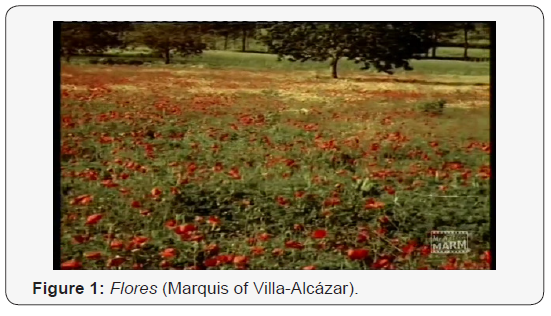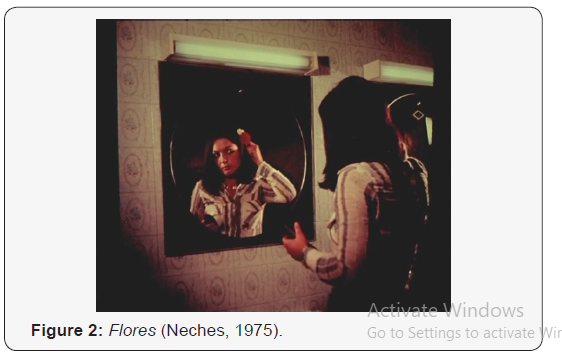Towards a Reformulation of the Spanish Agrarian Documentary from a Gender Perspective through the Films of the Marquis of Villa-Alcázar and José Neches
Ana Melendo*
Department of Art History, Professor Holder of the University of Cordoba, Spain
Submission: July 20, 2018; Published: July 25, 2019
*Corresponding author: Ana Melendo, Professor Holder of the University of Cordoba, Department of Art History, Historia del Arte Area, Faculty of Philosophy and Letters, 14071 Cordoba, Spain
How to cite this article: Ana Melendo. Towards a Reformulation of the Spanish Agrarian Documentary from a Gender Perspective through the Films of the Marquis of Villa-Alcázar and José Neches. Glob J Arch & Anthropol. 2019; 10(2): 555785. DOI: 10.19080/GJAA.2019.10.555785
Mini Review
In addition to being a source for the study of agricultural communities, films set in rural contexts can also be analysed in terms of how cinema represents the rural world, depending on the type of discourse concerned (documentary or fiction), the era and historical context in which they were made, and the themes they explore. The documentary, or more broadly speaking, non-fiction film, is a genre that can be traced right back to the very origins of cinema and has served as a “cornerstone of the evolution of the filmic style” [1], due mainly to the quality of veracity intrinsic to the cinematographic image. However, after they ceased production, two decades would have to pass before scholars began studying one of Spain’s most important documentary archives: the NO-DO newsreels of the Franco era. The growing interest in reconstructing historical memory in Spain has given rise to new, revisionist perspectives on the past in different disciplines, focusing particularly on examining those vestiges of the past that possess a special value for the construction of common values and identities.
This is the case of the studies that we have been conducting for several years now in relation to the film collections held by the Spanish Ministry of Agriculture. Our objective has been to examine a historical-artistic heritage which, both for its association with particular historical contexts (the first decades of the twentieth century, the Spanish Republic, the Franco era in its autarkic, developmentalist and post-Francoist stages, and the subsequent transition to democracy), and for its enshrinement in the public memory through the films and their unique use of agrarian ethnography, ideology and aesthetics, constitutes a decisive piece of film documentary history in Spain.
To this end, we have analysed the films of the Marquis of Villa-Alcázar, and subsequently the filmography of José Neches. Based on the results obtained, we have been able to confirm that both served to consolidate one of the most fruitful periods in documentary film production at the Ministry of Agriculture and one of the most productive, as noted above, in the history of the Spanish rural documentary. The extensive work of these two filmmakers should be classified within the genre of the scientific, informational and educational documentary because, quite apart from the question of their intended audience, there is a very obvious need in these films to communicate and exhibit the abundant knowledge and skills associated with the agricultural sector, with a highly persuasive message. In the studies conducted to date we have been able to establish, as Eduardo Rodríguez Merchán suggests, that these audio-visual records “are not classical ethnographic documentaries, but pedagogical documents based on ethnographic material” [2]. We can therefore assert that, although they may be viewed as part of the ethnographic documentary tradition, they are notable for the hallmarks of a cultural, economic and political network that makes them highly valuable and productive instruments for the recovery of Spain’s collective memory.
The films of the Marquis and Neches are also interesting from a visual perspective, as each one in his own way presents a series of constants that contribute to the consolidation of two easily identifiable styles. As Agustín Gómez has noted, these are documentaries that can help us “to understand the situation of agriculture, livestock breeding and reforestation; the investments and projects for modernization, including the development plans” [3]. But they can also provide us with a closer view of the rural context and the people who inhabited it, including the women, who occupy an important place in these pictures, even if they are not the explicit subject of the film and do not play a leading role in most cases
With an eminently patriarchal discourse, the woman appears “labelled” and “sidelined”, as there is a bias that favours certain aspects of their lives while omitting others. One example of this can be found in two documentaries by each filmmaker that bear the same title: Flores [4] and Flores. This comparative analysis serves to demonstrate how the flower is associated with the feminine in these documentaries as a symbol of purity or to highlight female beauty, albeit in a different visual form in each case. In both cases, these are the only documentaries by the filmmakers in which the narrator’s voice is female, in a gesture of extreme sentimentality associated with women. But beyond this detail, and of relevance to my hypothesis here, both documentaries feature a prologue and an epilogue that contain the key elements of the indoctrinating message in relation to gender that they were intended to convey [5,6].
Focusing exclusively on the prologues as examples of this idea, the Marquis’ film begins with a shot that is striking for the red and yellow hues of a field of flowers. But this image would be of little significance if it were not for a female voice-over that unabashedly echoes Francoist discourse by establishing a metaphoric link between this field full of poppies and hedge mustard and the Spanish flag, a symbol that exemplifies the unity of a country for which the slogan promulgated by the Regime is: Spain is one, great and free (Figure 1). In what follows, the fertility of the earth is placed in relation to female fertility and its depiction as a reproductive woman, expressed through the cultivation of carnations, which is associated here with the images of women that are central in the following shots, as evidenced by the close-ups in which the camera turns them into protagonists in a sequence that will not be repeated in the rest of the documentary [7-9].

Neches, meanwhile, uses the opening of his film (which I have classified here as a prologue) to explain to the spectator the vital importance of flowers in human social interaction, using language that is unquestionably sexist. Thus, a series of photographs appearing in succession on the screen testify to the importance of this fragile, beautiful and symbolic element in events like weddings, the birth of a child, first communions and, finally, deaths. In these cases, the woman becomes a protagonist through the presence of the narrator, thereby responding to another of those paradigms in which flowers have commonly been associated with the feminine. Moreover, the words spoken in the voice-over seem to take on special meaning because they are illustrated with photographs in which the woman occupies the centre of attention: a young woman holding a bouquet on her wedding day; a new mother; a girl picking flowers in a field; another girl dressed for communion; or a woman putting a flower in her hair to accentuate her beauty (Figure 2).

The woman is associated with an aesthetic role that turns her into a decorative object that enhances the importance of a product-in this case, flowers. But beyond the innocence that may be viewed as intrinsic to the association of flowers with femininity, this film is, once again, notable for the hallmarks of an ideological network that reflects the need to differentiate the genders, to identify the Church as one of the de facto powers of the day, to defend the role of the woman as a wife and mother, and to depict young women as objects of desire whose freshness goes hand-in-hand with the freshness of flowers. In both these films, then, we find the use of stereotypes that are significant because they allow the use of general features for the organization of a whole range of information that facilitates the placement of a product in the receiver’s mind in a predetermined way.
References
- Castro de Paz JL (2001) La conciencia y la forma. La espalda del mundo. In Josep Maria Catalá, Josetxo Cerdá and Casimiro Torreiro (Editors.), Imagen, memoria y fascinació Notas sobre el documental en España, IV Festival de Cine Español, Ocho y Medio, Libros de Cine, Madrid, Spain.
- Rodríguez Merchán E (2013) Pró In: Gómez-Tarín FJ, Parejo N (Eds.), Discursos y narraciones en el documental rural: el Marqués de Villa-Alcázar, CAL, Cuadernos Artesanos de La Latina/XX, La Laguna, Tenerife, p. 7-13.
- Gómez A (2015) Modos de hacer y de pensar el documental científico rural. In El marqués de Villa Alcázar, Ministerio de Agricultura, Alimentación y Medio Ambiente, Madrid, Spain, p. 47.
- Poyato P (2015) Sobre los mecanismos de captura del interés del espectador en los documentales del marqués de Villa Alcá In El marqués de Villa Alcázar, Ministerio de Agricultura, Alimentación y Medio Ambiente, Madrid, Spain, p. 21-37.
- Melendo A (2013) Catequesis y vitaminas a pie de barbecho: la mujer en las primera charlas cinematográficas del marqués de Villa Alcá In: Gómez-Tarín FJ, Parejo N (Eds.), Discursos y narraciones en el documental rural: el marqués de Villa-Alcázar. CAL, Cuadernos Artesanos de La Latina/XX., La Laguna, Tenerife, p. 73-93.
- Melendo A (2017) La construction plástica de la imagen femenina en las películas del marqués de Villa Alcá De 1943 a 1945. Revista Arenal 2: 477-508.
- Melendo A (2017) Reconstrucción de la memoria histórica a propósito de la mujer en la obra del marqués de Villa Alcá In De cultura visual y documentales en España (1934-1966): La obra cinematográfica del marqués de Villa Alcázar. Comares, Granada, pp. 127-166.
- Melendo A (2018) Visibles pero diferentes: la mujer en la obra documental agraria de José Anales de la Historia del Arte, 28: 315-318.
- Melendo A (2019) La voces narrativas en la obra documental agraria de José Signa 28: 1057-1088.






























